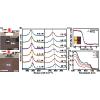当前位置:
X-MOL 学术
›
Phys. Rev. Appl.
›
论文详情
Our official English website, www.x-mol.net, welcomes your
feedback! (Note: you will need to create a separate account there.)
In-Plane and Interfacial Thermal Conduction of Two-Dimensional Transition-Metal Dichalcogenides
Physical Review Applied ( IF 3.8 ) Pub Date : 2020-03-24 , DOI: 10.1103/physrevapplied.13.034059 Yifei Yu , Tamzid Minhaj , Lujun Huang , Yiling Yu , Linyou Cao
Physical Review Applied ( IF 3.8 ) Pub Date : 2020-03-24 , DOI: 10.1103/physrevapplied.13.034059 Yifei Yu , Tamzid Minhaj , Lujun Huang , Yiling Yu , Linyou Cao

|
We elucidate the dependence of the in-plane and interfacial thermal conduction of two-dimensional (2D) transition-metal dichalcogenide (TMDC) materials (including , , and ) on the materials’ physical features, such as size, layer number, composition, and substrates. The in-plane thermal conductivity k is measured at suspended 2D TMDC materials and the interfacial thermal conductance g is measured at materials supported on substrates, both through Raman thermometry techniques. The thermal conductivity k increases with the radius R of the suspended area following a logarithmic scaling as k∼log(R). k also shows a substantial decrease from monolayer to bilayer, but only changes slightly with a further increase in the layer number. In contrast, the interfacial thermal conductance g has a negligible dependence on the layer number, but g increases with the strength of the interaction between 2D TMDC materials and the substrate, substantially varying among different substrates. The result is consistent with theoretical predictions and clarifies much inconsistence in the literature. This work provides useful guidance for thermal management in 2D TMDC materials and devices.
中文翻译:

二维过渡金属硫属元素化物的面内和界面热传导
我们阐明了二维(2D)过渡金属二硫化碳(TMDC)材料(包括以下材料)的面内和界面热传导的依赖性 , 和 )材料的物理特征,例如尺寸,层数,成分和基材。均通过拉曼测温技术在悬浮的2D TMDC材料上测量面内导热系数k,并在支撑在基板上的材料上测量界面导热系数g。热传导率ķ与半径增大- [R以下的对数标度为悬浮区的ķ ~log([R )。k也显示出从单层到双层的显着减少,但是随着层数的进一步增加仅略有变化。相反,界面导热系数g具有对层数的可忽略的依赖性,但是g随2D TMDC材料和衬底之间的相互作用的强度而增加,在不同衬底之间基本上变化。结果与理论预测相符,并澄清了文献中的许多不一致之处。这项工作为2D TMDC材料和设备中的热管理提供了有用的指导。
更新日期:2020-03-26
中文翻译:

二维过渡金属硫属元素化物的面内和界面热传导
我们阐明了二维(2D)过渡金属二硫化碳(TMDC)材料(包括以下材料)的面内和界面热传导的依赖性 , 和 )材料的物理特征,例如尺寸,层数,成分和基材。均通过拉曼测温技术在悬浮的2D TMDC材料上测量面内导热系数k,并在支撑在基板上的材料上测量界面导热系数g。热传导率ķ与半径增大- [R以下的对数标度为悬浮区的ķ ~log([R )。k也显示出从单层到双层的显着减少,但是随着层数的进一步增加仅略有变化。相反,界面导热系数g具有对层数的可忽略的依赖性,但是g随2D TMDC材料和衬底之间的相互作用的强度而增加,在不同衬底之间基本上变化。结果与理论预测相符,并澄清了文献中的许多不一致之处。这项工作为2D TMDC材料和设备中的热管理提供了有用的指导。











































 京公网安备 11010802027423号
京公网安备 11010802027423号